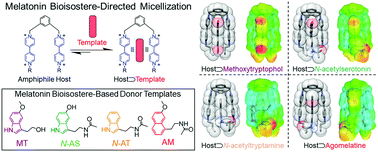Classical and non-classical melatonin receptor agonist-directed micellization of bipyridinium-based supramolecular amphiphiles in water†
Abstract
The addition of molecular recognition units into structures of amphiphiles is a means by which soft matter capable of undergoing template-directed micellization can be obtained. These supramolecular amphiphiles can bind with molecular templates using non-covalent bonding interactions, forming host–guest complexes that hold the amphiphiles together as they undergo micellization. In most cases, such templates are synthesized and designed for a specific molecular recognition motif. It is not clear, however, to what extent these types of amphiphile systems are responsive to members of a biologically derived class of molecular targets, for example, melatonin receptor agonists and their numerous isosteres. Herein, we describe the template-directed micellization and arrangement at the air–water interface of a bipyridinium-based gemini surfactant, driven by the influence of donor–acceptor CT interactions with a series of bioactive classical and non-classical melatonin isosteres. Under the conditions of templation by either 5-methoxytryptophol, N-acetylserotonin, N-acetyltryptamine, or the pharmaceutical agent agomelatine, favorable Gibbs free energies of micellization were observed with decreases in CMC by up to 70%, and concomitant increases of 28% in surface pressure, and decreases of 20% in contact angle versus untemplated solutions. Solid state thermochromic transition temperatures for inkjet-printed patterns of the templated amphiphile solutions were inversely correlated with trends observed for their respective CMCs, and exhibited no correlation to their binding constants. These findings contend for the generalizable use of melatonin receptor agonists as targets and/or templates for chemical systems, which rely on π-stacking donor–acceptor CT interactions in water to facilitate the actions of binding, sequestration, or template-directed self-assembly.

- This article is part of the themed collection: The Mechanics of Supramolecular Chemistry


 Please wait while we load your content...
Please wait while we load your content...